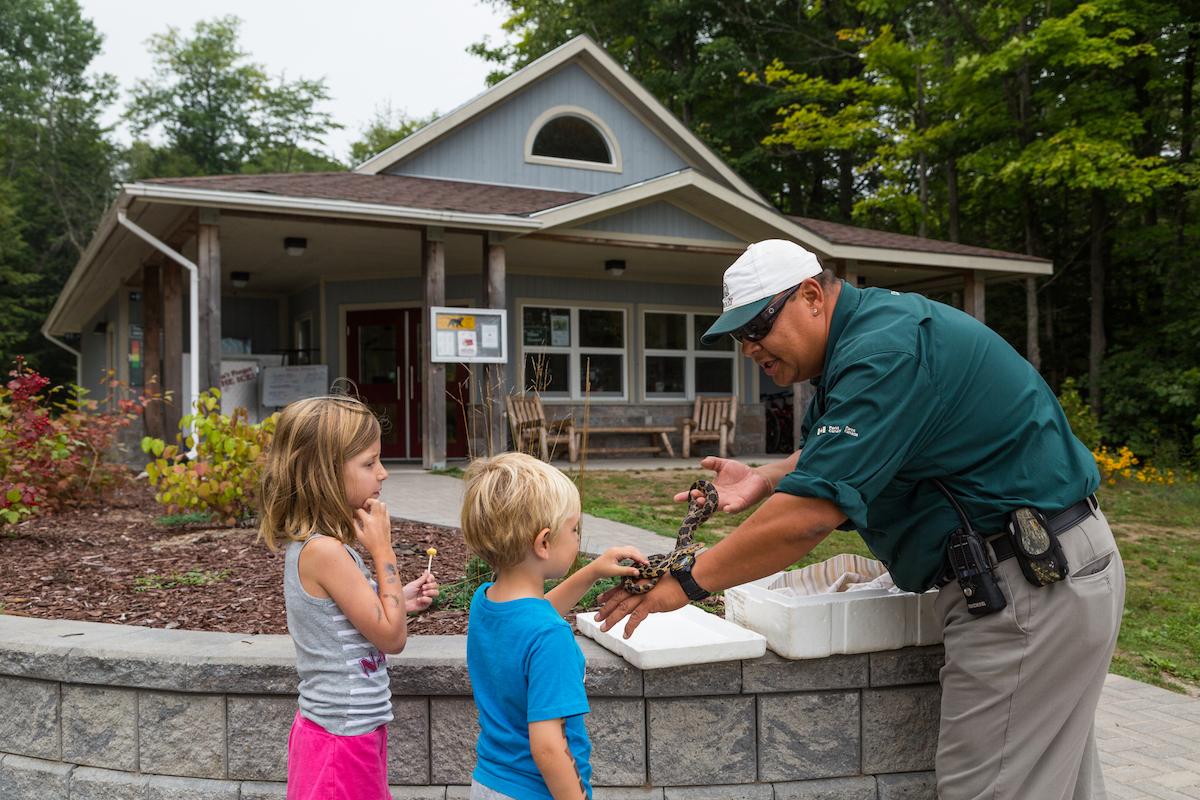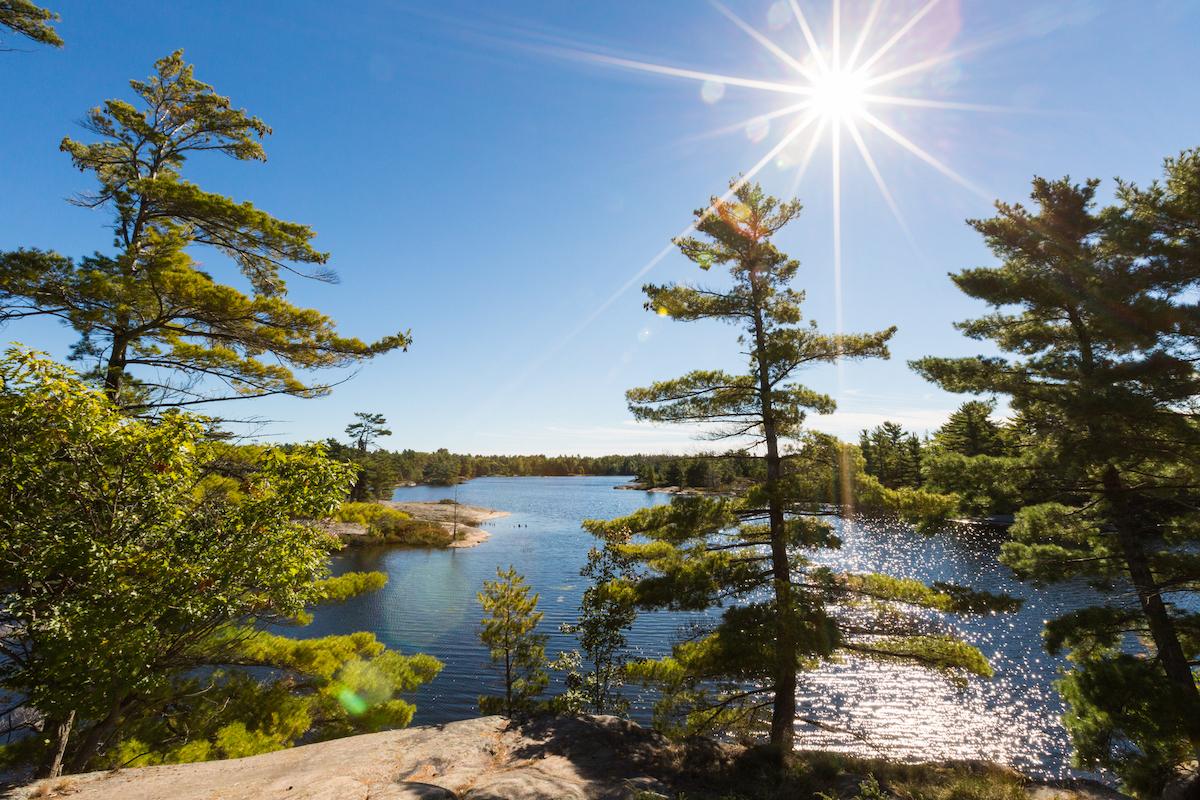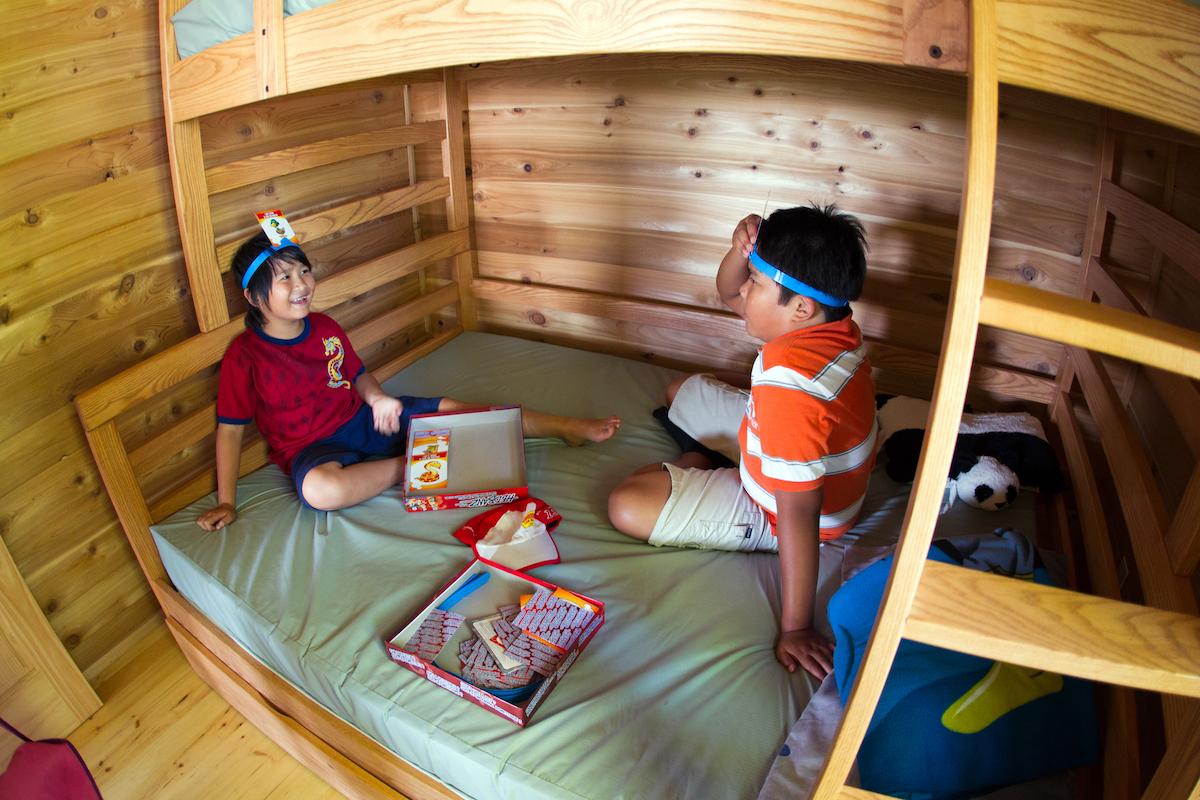
Introducing young visitors to a snake (before Covid) on Beausoleil Island at Georgian Bay Islands National Park/Parks Canada
It’s something that every national park struggles with — balancing the need to protect its natural and cultural resources with the mandate to showcase itself and attract a good array of people but not too many.
Georgian Bay Islands National Park — an island-based park that’s only open for half of each year and that includes Beausoleil Island National Historic Site — drew 40,000-odd visitors a year before the pandemic. Now as it finalizes a new management plan that will guide the next decade, it is working on “enabling access and enhancing a diverse and enjoyable visitor experience.”
That’s one of the plan’s four key strategies and it means rehabilitating, repairing and designing a new “climate resilient/adaptable shoreline infrastructure” on Beausoleil Island to “instill a sense of wonder from the moment of arrival.” As well as encouraging a more family-friendly environment, the park will contend with sacred and traditional use, day use, camping and boating plus the need for barrier free and accessible options.
“It couldn’t handle too many people, but we also have to have a place to share this culture,” Indigenous liaison officer Shawn Corbiere said during a recent virtual consultation session on the plan. He is Ojibwe and has been with Parks Canada for 16 years.

The island park boasts iconic Canadian landscape/Parks Canada
The park is close to several First Nation and Métis communities, and within an area of traditional interest to others. Archaeological finds show human activity and settlement on the island for thousands of years since the late Paleo-Indian period. The main island has been used by the Anishinaabeg as a traditional stopping place, seasonal campsite and a reserve in the mid-19th century. It’s named after Louis Beausoleil, a Métis settler whose 1819 homestead stood at the island’s southern tip.
While acknowledging that “everything humans do is detrimental no matter how small it is,” Corbiere said Parks Canada's parks and sites are great platforms to share Indigenous culture. Here there are plans for a cultural sharing space and to teach staff cultural protocols on how to give respect to Mother Earth.
Just 90 minutes north of Toronto in cottage country, Canada’s smallest national park was established in 1929 and protects 50 islands within the world’s largest freshwater archipelago. It’s part of the UNESCO Georgian Bay Biosphere Reserve and stretches for 50 kilometres (31 miles) along eastern Georgian Bay. Beausoleil Island, the main island and a national historic site, is a 15-minute boat-ride from Honey Harbour.

The Five-lined skink is a species-at-risk in Canada/Parks Canada
The park is home to more than 30 species of amphibians and reptiles, including 13 that are species-at-risk. Twenty-five plants and animals are designated as species-at-risk. The landscape straddles two natural bioregions — the Great Lakes Precambrian Shield and St. Lawrence Lowlands. People come on day trips — the park runs a Day Tripper shuttle boat — and overnight to hike, bike, swim, boat and camp.
“The park’s iconic landscapes, which inspired the Group of Seven to create distinctly Canadian works of art, continue to be a source of inspiration today,” the management plan notes.
The park is replacing its 2010 management plan with a new one to guide decisions and actions in protecting, presenting and operating the park. Beausoleil Island wasn’t designated a national historic site until 2011. The park has boosted the presence of Indigenous culture and worked cultural awareness into park programing and projects, while improving ecological integrity, the visitor experience and infrastructure.
Pat Yarnell, a senior planner with the Parks Canada Agency in Winnipeg, told those gathered for the online consultation that he supports teams across the country who’re writing their new plans. The plans used to be thicker and more detailed, but now simply provide strategy and direction so they’re “an easier tool to use.” The Georgian Bay Islands plan is 16 pages.

Roofed accommodations have been a hit with first-time visitors/Parks Canada
Above all, these plans provide accountability to Canadians about the vast amount of land that Parks Canada manages. “It’s us trying to be transparent about what our priorities are,” Yarnell explains. Parks Canada is mandated to maintain and improve ecological and commemorative integrity, facilitate high-quality visitor experience opportunities, create awareness and build partnerships. Its top priorities are Indigenous relations, climate change, and diversity and accessibility.
Work on Georgian Bay Island's plan began in 2018 and should wrap up this fall. Like all management plans, it includes an introduction, overview of the park/site’s significance, planning context, vision, key strategies, management areas, zoning and summary of strategic environmental assessment.
Georgian Bay Islands has four key strategies:
• Manage conservation and climate change adaptation within a broader fragmented ecosystem.
• Enable access and enhance a diverse visitor experience.
• Strengthen formal Indigenous relations and share the heritage and culture.
• Build national park awareness and community support.

Loading cut phragmites for transport/Parks Canada
The park offers facilities and services from late May until early October. Although visitation averages 41,000 to 44,000 a year, demand for day trips is up, traditional camping has declined and roofed accommodation (rustic cabins and oTENTiks) have been popular with first-time visitors. Local boaters don’t always access the park through the common entrance or even pay fees. It’s home to two YMCA camps.
Phragmites — a European shoreline reed — are rapidly invading the south side of Beausoleil Island and displacing native species. Extreme high water, rapid fluctuations in lake levels, along with ice, wind and seich (standing wave) events have eroded shoreline and damaged infrastructure and facilities.
In 15 years, Georgian Bay Islands plans to be "renowned" for eight things including:
• Having an exceptional ecosystem with incredible biodiversity.
• Leading edge, forward-thinking conservation management.
• Being a place where Indigenous heritage and culture are respectfully woven through conservation management and visitor programs, and Indigenous partners contribute to decision making related to heritage-place management.
• Being a regional leader for conservation and tourism partnerships.

Giants Chair on Beausoleil Island is one of the park's iconic photo stops/Parks Canada
On the zoning front, Georgian Bay Islands is made up of wilderness areas (17 per cent) that are protected with minimal human intrusion or facilities, natural environment areas (82 per cent) that support a range of visitor experiences, and outdoor recreation areas (1 per cent) that supports more intensive visitor use and major facilities.
Katherine Patterson, field unit superintendent for Georgian Bay and Eastern Ontario, said Georgian Bay Islands doesn’t want to get into the situation that faced Fathom Five National Marine Park, which saw visitation jump from 20,000 to 140,000 in five years. The goal, she says, is “to stay ahead of growth.”
The draft management plan for Georgian Bay Islands includes a vision statement that reads: “Shaped by wind and water, our vision is to be a peaceful gathering place deeply rooted in memory and in connection to nature.”

 Support Essential Coverage of Essential Places
Support Essential Coverage of Essential Places



